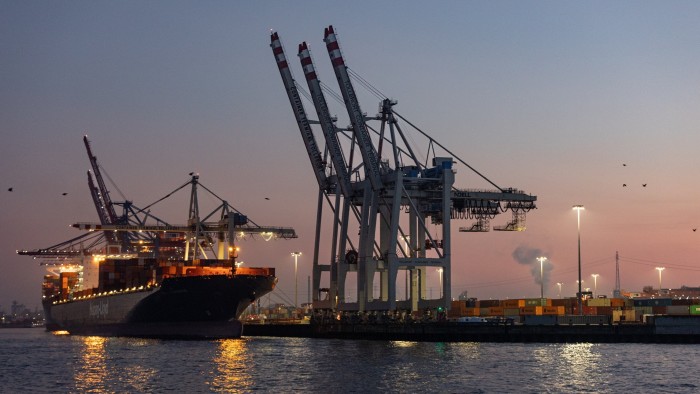Stay informed with free updates
Simply sign up to the Eurozone economy myFT Digest — delivered directly to your inbox.
The European Commission has cut its growth forecasts for the Eurozone as US trade policy unleashes economic disruption.
The EU executive now expects the 20-strong currency area to grow by 0.9 per cent this year — down from a previous estimate of 1.3 per cent published in November. It has also shaved its growth outlook for 2026 to 1.4 per cent, from 1.6 per cent previously. Estimates were also downgraded slightly for the EU as a whole.
“The EU economy is demonstrating resilience amid high trade tensions and a surge in global uncertainty,” said EU economy commissioner Valdis Dombrovskis on Monday, adding: “But we cannot be complacent. The risks to the outlook remain tilted to the downside.”
The commission’s forecast cuts come after US President Donald Trump announced a slew of tariffs on the rest of the world in April, including 20 per cent “reciprocal” levies on most EU imports. These were cut to 10 per cent for 90 days on April 9 to give the two sides time to negotiate. Tariffs of 25 per cent on EU steel, aluminium and cars still stand.
The latest growth outlook assumed reciprocal tariffs on most EU products would end up at 10 per cent, while sector-specific tariffs would stay at 25 per cent, said the commission.
But given that ongoing negotiations are yet to yield results, the commission recognised that a further escalation in trade tensions could depress GDP.
The commission also factored in “a significant reduction” in US-China trade. China and the US earlier in May negotiated a trade ceasefire that slashed the headline US tariff on Chinese imports from 145 per cent to 30 per cent for at least 90 days. Levies above 100 per cent were “not assessed as tenable” by the commission.
Inflation is expected to reach the European Central Bank’s target of 2 per cent faster than expected by the middle of this year, and fall to 1.7 per cent on average next year, according to the commission’s latest estimates.
The Eurozone economy has outperformed expectations in recent quarters, and expanded by 0.3 per cent in the first three months of the year, although economists attributed the performance to one-off factors such as the large number of American multinational companies that process non-US revenue through their Irish subsidiaries.
The commission on Monday revised down growth forecasts across the bloc. The Germany economy is now expected to flatline this year — previously the commission had estimated growth of 0.7 per cent for Europe’s biggest economy — before rebounding in 2026 to expand 1.1 per cent.
Germany’s €500bn infrastructure fund, as well as changes to national debt rules to allow for a boost in defence spending, “were not deemed sufficiently detailed to be included” in the forecast, the commission wrote.
France and Italy were expected to fare slightly better, according to the commission, with expected growth of 0.6 and 0.7 per cent respectively in 2025 — although these forecasts were previously 0.8 and 1 per cent.
Ireland, Spain and Greece should continue to outperform average Eurozone growth.
Source link









